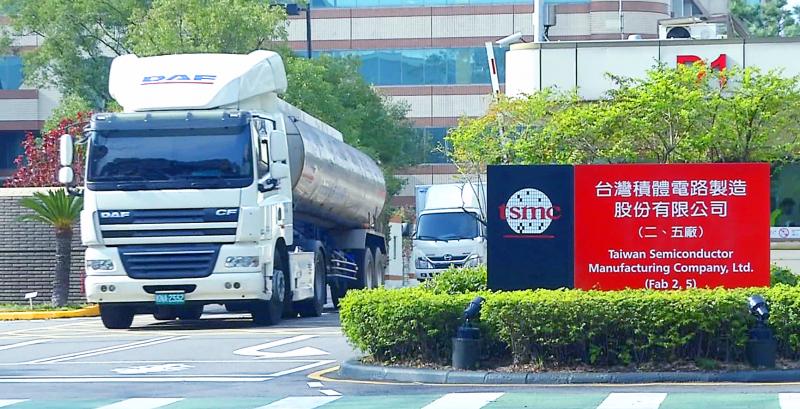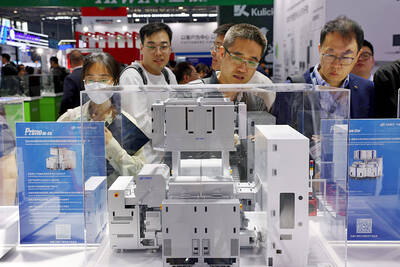Taiwan Semiconductor Manufacturing Co (TSMC, 台積電) last year saved almost 2 million tonnes of water as part of its efforts to fulfill its commitment to reach net-zero emissions by 2050, the company’s financial disclosure report said.
To reach its zero emissions goal, TSMC has been taking action to broaden its green influence and drive industry toward low-carbon sustainability, chairman Mark Liu (劉德音) said in the company’s Task Force on Climate-related Financial Disclosures report released last week.
TSMC saved 1.927 million tonnes of water last year by adopting measures such as reducing water consumption by facility systems, increasing wastewater recycling by facilities and decreasing water discharge from the systems, the report said.

Photo: CNA
Last year, it also invested NT$1.6 billion (US$57.69 million) in water conservation and recycling equipment, and spent an additional NT$1.2 billion on equipment operation and maintenance, it said.
By 2030, TSMC aims to reduce the amount of water it uses by 30 percent from 2010, the report said, adding that its water consumption last year fell 8.9 percent from 2010.
After Taiwan experienced a major water shortage from the end of last year to May, TSMC compiled statistics for drought risk assessments in the report, which showed that from 1986 to 2005 the longest Hsinchu City and Hsinchu County had gone without rain was 40 days, while for Taichung it was 52 days and for Tainan 62 days.
The number of days Hsinchu City and Hsinchu County, Taichung and Tainan would go without rain in 2035 is forecast to rise 4.15 percent, 2.42 percent and 2.28 percent respectively from 2016, the company said.
From 2081 to 2100, the longest stretch without precipitation in Hsinchu City and Hsinchu County could increase 14.44 percent from the 1985-to-2005 period, and it could grow 11.33 percent for Taichung and 10.73 percent for Tainan, it said.
If a drought occurs every 10 years, it could cause an average reduction of 0.7 to 1.1 percent in TSMC’s annual operating revenue, the company said.
As water shortages in Taiwan are likely to worsen, TSMC said it has also established a comprehensive water monitoring mechanism to regularly check the status of water supplies in the country.
The company is improving its water conservation measures, increasing the recycling rate of process wastewater and establishing comprehensive monitoring mechanisms for water supply, the report said.
It is also expanding the use of reclaimed water, and preparing water trucks to minimize the effect of water shortages on operations and eliminate production interruptions, it said.

With this year’s Semicon Taiwan trade show set to kick off on Wednesday, market attention has turned to the mass production of advanced packaging technologies and capacity expansion in Taiwan and the US. With traditional scaling reaching physical limits, heterogeneous integration and packaging technologies have emerged as key solutions. Surging demand for artificial intelligence (AI), high-performance computing (HPC) and high-bandwidth memory (HBM) chips has put technologies such as chip-on-wafer-on-substrate (CoWoS), integrated fan-out (InFO), system on integrated chips (SoIC), 3D IC and fan-out panel-level packaging (FOPLP) at the center of semiconductor innovation, making them a major focus at this year’s trade show, according

DEBUT: The trade show is to feature 17 national pavilions, a new high for the event, including from Canada, Costa Rica, Lithuania, Sweden and Vietnam for the first time The Semicon Taiwan trade show, which opens on Wednesday, is expected to see a new high in the number of exhibitors and visitors from around the world, said its organizer, SEMI, which has described the annual event as the “Olympics of the semiconductor industry.” SEMI, which represents companies in the electronics manufacturing and design supply chain, and touts the annual exhibition as the most influential semiconductor trade show in the world, said more than 1,200 enterprises from 56 countries are to showcase their innovations across more than 4,100 booths, and that the event could attract 100,000 visitors. This year’s event features 17

Germany is to establish its first-ever national pavilion at Semicon Taiwan, which starts tomorrow in Taipei, as the country looks to raise its profile and deepen semiconductor ties with Taiwan as global chip demand accelerates. Martin Mayer, a semiconductor investment expert at Germany Trade & Invest (GTAI), Germany’s international economic promotion agency, said before leaving for Taiwan that the nation is a crucial partner in developing Germany’s semiconductor ecosystem. Germany’s debut at the international semiconductor exhibition in Taipei aims to “show presence” and signal its commitment to semiconductors, while building trust with Taiwanese companies, government and industry associations, he said. “The best outcome

Semiconductor equipment billings in Taiwan are expected to double this year, as manufacturers in the industry are keen to expand production to meet strong global demand for artificial intelligence applications, according to SEMI, which represents companies in the electronics manufacturing and design supply chain. Speaking at a news conference before the opening of Semicon Taiwan trade show tomorrow, SEMI director of industry research and statistics Clark Tseng (曾瑞榆) said semiconductor equipment billings in Taiwan are expected to grow by an annual 100 percent this year, beating an earlier estimate of 70 percent growth. He said that Taiwan received a boost from a